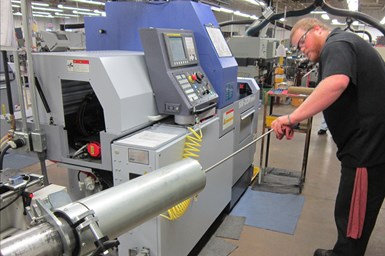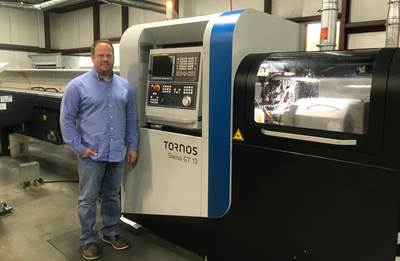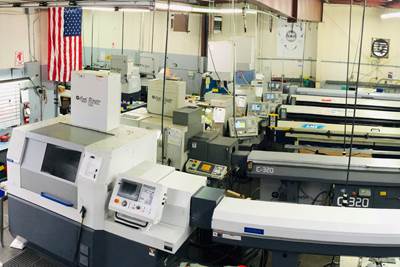Share




This content originally appeared on our sister site, Production Machining. Visit productionmachining.com to explore more precision machining topics.

Some time ago, I got the chance to visit Vallorbs, a machine shop in Bird-in-Hand, Pennsylvania, that has a wealth of experience with Swiss-type lathes. Of course, it also faces the challenges of needing to train new employees how to run such sophisticated machines.
Like many other shops, Vallorbs starts with the basics when training new operators, including instructing how to use micrometers and read part prints as well as explaining the differences between a sliding-headstock machine versus a conventional turning center. However, running a Swiss-type isn’t the same as running a traditional lathe. Here are a few points it communicates to its new Swiss operators:
- Know the difference between a headstock collet and a guide bushing. While the revolving collet must be adjusted tighter to grip the bar when the sliding headstock moves in or out, the guide bushing must be adjusted so it is loose enough to enable the bar to pass through, but not too loose to reduce the bar support needed near the point of the cut. The company maintains that the only real way to learn how to properly adjust the guide bushing is through experience and getting the “feel” of a proper adjustment in which there’s some drag when rotating the bar, but not too much drag. Vallorbs typically purchases guide bushings that are 0.001 inch bigger than the barstock diameter. That way, an operator will not have to tighten the guide bushing more than 0.005 inch. It feels tightening it any more than that can cause the slots in the guide bushing to close too tightly, which can prevent the necessary lubricating oil from flowing into the bushing.
- Measure each bar before installing. Because the guide bushing must be loosened each time a remnant is removed so as not to gall the bushing during removal, the bushing has to be readjusted each time a new bar is loaded. Most ground bars Vallorbs uses have a diameter accuracy of ±0.0005 inch, meaning the amount of adjustment can vary from bar to bar. The company says that’s not a problem, because an operator needs to readjust the guide bushing for each new bar anyway. What is problematic is if the diameter of a bar varies along its length. For example, say there is a section of the bar where the diameter is a few tenths smaller than nominal. This will diminish the support that the guide bushing would otherwise provide, leading to higher runout and concentricity errors. Measuring a bar before loading it into the bar feeder will reveal any diameter deviations.
- Take care when offsetting tools. Operators of Swiss-types must remember that a single tool might be used to perform a number of different operations. Therefore, adjusting the offset for a tool that’s currently producing an oversized diameter, for instance, might adversely affect subsequent operations the tool performs for that particular job. For example, the adjustment could cause the tool to rough a different diameter too deeply, meaning that for the subsequent finishing pass a tool will be cutting air. Even if a job traveler describes every operation each tool will perform, this concept can still be tough to comprehend for someone who is new to Swiss-types.
- Know the workpiece material. Some materials are harder on tools than others. Operators might have to change offsets when running Inconel 718 quite often, meaning they must diligently measure each part after machining. This might not be the case when machining less demanding materials such as aluminum.
- Mind the coolant lines. After getting a new job running, a setup person typically will watch to see that the coolant is being directed to the proper location and that chips are being evacuated as they should be. During production, though, it’s possible that an operator could bump a flexible coolant line out of position when changing a tool or insert, for example. Left undetected, this could cause problems such as tool breakage, shortened tool life or poor surface finish.
- Get a feel for finishes. A turned feature looks different than a milled one. Both might have the same finish rating, but the milled surface includes witness marks that turning doesn’t produce. Vallorbs believes this sometimes takes an operator a little time to appreciate. Similarly, a drilled hole looks different from one that’s been bored. However, if a hole tolerance is loose enough, it might be possible to simply drill the hole and skip the boring operation. When in doubt, operators might simply just need to check the surface finish specification on the part print.
Related Content
Building Machines and Apprenticeships In-House: 5-Axis Live
Universal machines were the main draw of Grob’s 5-Axis Live — though the company’s apprenticeship and support proved equally impressive.
Read MoreWorkholding Fixtures Save Over 4,500 Hours of Labor Annually
All World Machinery Supply designs each fixture to minimize the number of operations, resulting in reduced handling and idle spindle time.
Read MoreInside Machineosaurus: Unique Job Shop with Dinosaur-Named CNC Machines, Four-Day Workweek & High-Precision Machining
Take a tour of Machineosaurus, a Massachusetts machine shop where every CNC machine is named after a dinosaur!
Read MoreFinding the Right Tools for a Turning Shop
Xcelicut is a startup shop that has grown thanks to the right machines, cutting tools, grants and other resources.
Read MoreRead Next
Swiss Shop Turns Precision into Profit
The quality demands for micro-machined parts are swiftly increasing. Shops must be ready and willing to adjust their machining strategies to fit the need.
Read MoreSwiss Shop Chooses CAM Over Hand Programming
This shop’s manual (by hand) CNC programming was slowing it down until it discovered a CAM software for Swiss-type lathes.
Read MoreLow Frequency Vibration Increases Job Shop’s Productivity
With the ability to machine difficult materials more efficiently while improving surface finish, this job shop is reaping the benefits of its Swiss-type lathes that incorporate low frequency vibration.
Read More

































